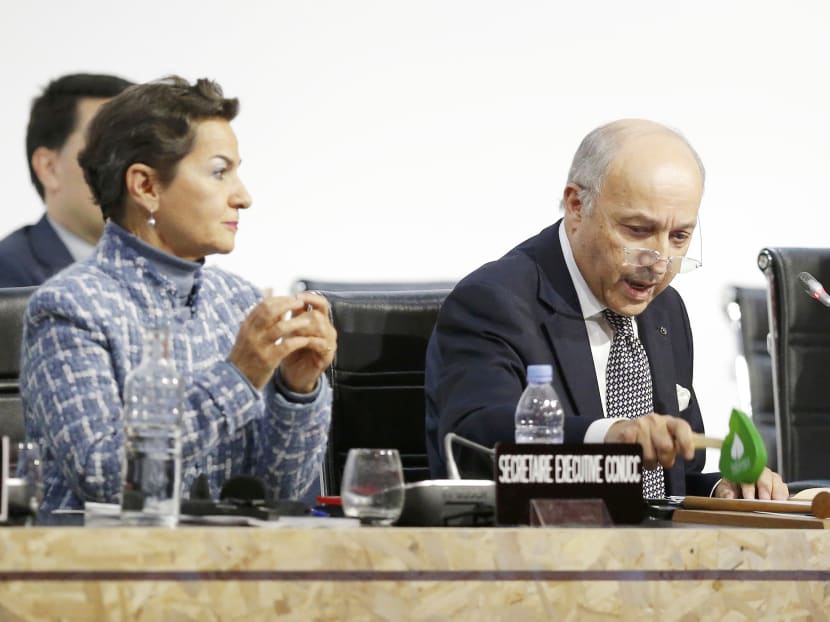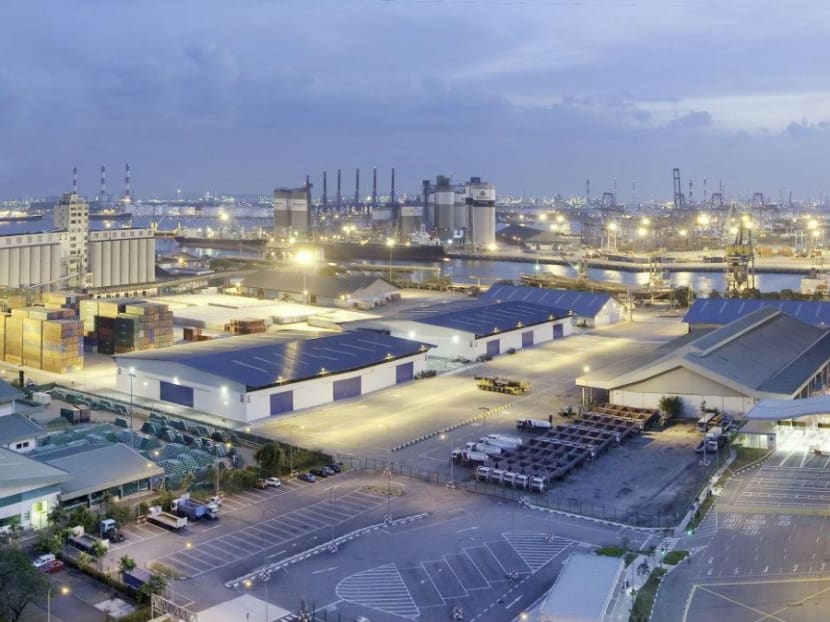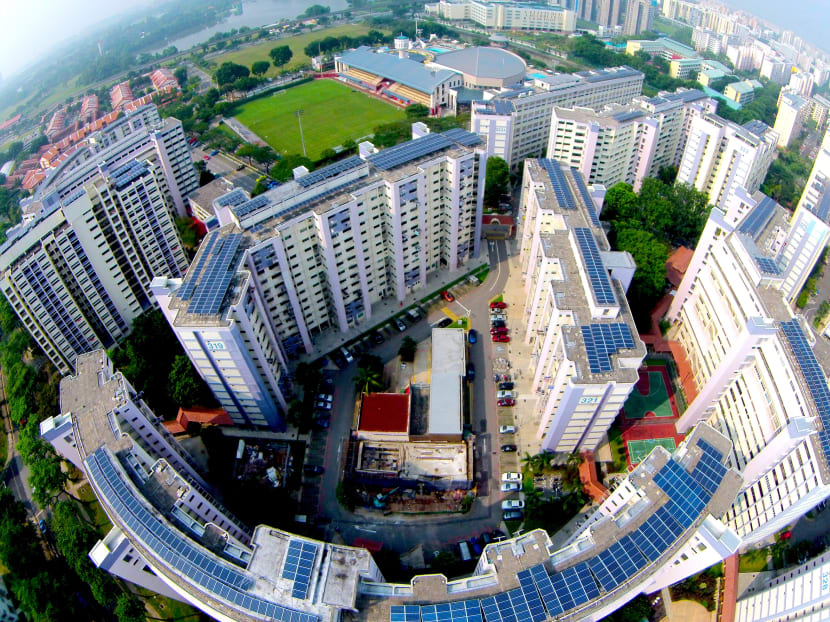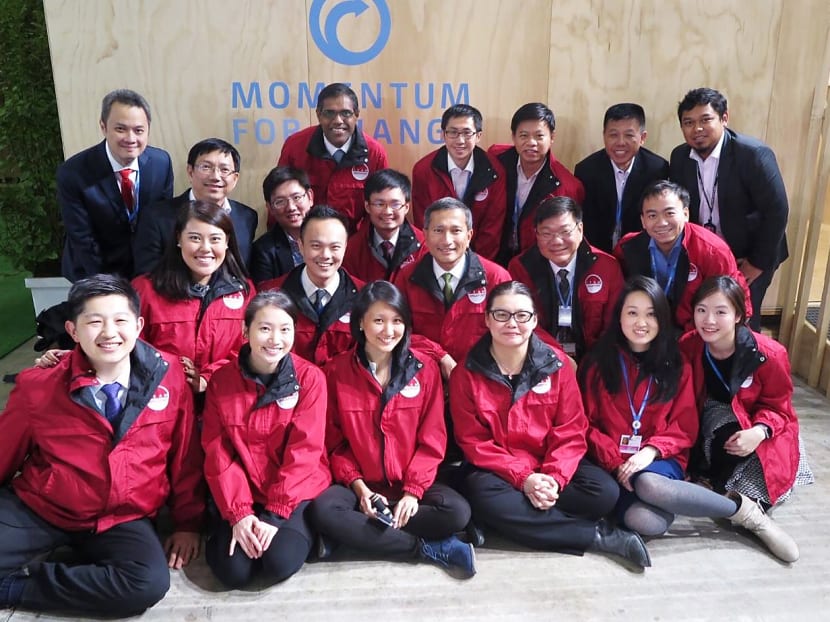The Big Read: Climate change talks - The little red dot’s big role
SINGAPORE — It was breakfast time at 7am but for the Singaporean negotiators participating in the Paris climate talks last week, their day was just coming to an end after yet another overnight session of hard bargaining among more than 190 countries on acceptable language for a global climate framework.
Team Singapore — led by Minister for Foreign Affairs Vivian Balakrishnan and consisting of several dozen senior and mid-level officials from across the civil service — would rest for a couple of hours before the next round of talks resumed.
For most of the officials, the two-week summit in Paris was the culmination of several years of calculated negotiations in different corners of the globe. By now, they knew the importance of having tenacity, stamina and finesse in seeking common ground with so many different nations for an unprecedented accord. On this home stretch, there was to be no giving up.
Negotiations on different articles in the agreement sometimes took place concurrently, and this meant the Singapore team had to stay alert and coordinated at all times.
The negotiators had also developed strategies to cope with the marathon talks, like ensuring they packed enough food — sandwiches, fruits and energy bars are the favourites for practical reasons — as moving from one meeting to another, there is often little time to sit down for a proper meal.
“Towards the end, we were sleeping only three to four hours a day. Especially during the informal negotiation sessions which ran overnight and ended at 6 am,” said Mr Terence Tan, a Desk Officer in the Ministry of Foreign Affairs’ (MFA) Climate Change Office.
There were a few occasions when the food outlets in the conference venue did not serve dinner, he said.
“Colleagues helped to ‘da bao’ (packet) food from outside. We dubbed it ‘Operation Food Security’,” he added.
“We then surreptitiously brought it into the marathon negotiations even though it was prohibited. (It was) either that or (we) go hungry.”

The talks finally concluded last Saturday, or Sunday morning Singapore time. As cheers and applause rang out across the hall when French Foreign Minister Laurent Fabiusbanged a small green gavel on the table to announce the historic climate deal, members of Team Singapore duly posed for selfies to celebrate the end of one chapter in a long journey.
Asked how he felt when the deal was finalised, Mr Tan replied: “A real mix of emotions. Ecstatic, relieved, a sense of disbelief, fortunate.”
“Just moments before, Parties were still bickering and things seemed to be on the brink. Suddenly, when the gavel went down and the deal was struck, we witnessed history… It was surreal,” he added.
Having played the role of a honest broker in helping to arrive at a global climate deal that will replace the Kyoto Protocol expiring in 2020, Singapore will now have to turn its attention towards concrete actions to deliver its pledge of cutting Emissions Intensity by 36 per cent from 2005 levels by 2030, and stabilise emissions with the aim of peaking around the same time.

The Paris deal came together following several years of hard work after the Copenhagen climate talks failed in December 2009, primarily over a lack of trust between countries .
Subsequent talks in Cancun, Durban, Doha, Warsaw and Lima focussed on trust building and growing the emerging areas of convergences.
France, as president of COP21 (21st Conference of the Parties to the United Nations Framework Convention on Climate Change - UNFCCC) this year, started preparing early by engaging Peru and engineering a seamless transition for decisions taken in Lima to Paris. Top French negotiators also criss-crossed the globe to better understand the concerns of the various negotiating blocs.
As negotiations kicked off late last month, the divisive issues of differentiation (how countries are divided in the UNFCCC as Annex One developed countries and Non-Annex One developing countries, with the former expected to take on greater responsibilities) as well as whether to aim to stop global temperatures rising more than 2°C above pre-industrial levels or push for a more ambitious 1.5°C target had yet to be resolved. The modalities through which developed countries will fund the actions taken by developing countries to address climate change were also not finalised.
Towards the end, Mr Fabius announced that he had set up a committee of foreign and environment ministers to carry out informal consultations around several clusters of outstanding issues.
“Overcoming mistrust by having honest brokers (ministers) in an open Indaba-type consultations was helpful in overcoming the difficult issues,” added Melissa Low, a research associate from the Energy Studies Institute (ESI) in the National University of Singapore (NUS), referring to consultations held in the African tradition of interdependence that were first introduced during the Durban Climate Change Conference in 2011. Ms Low attended the recent Paris talks as an observer, her fourth COP meeting.
Mr Fabius roped in Dr Balakrishnan to helm informal consultations among the ministers on differentiation, a topic seen as a potential deal-breaker . The Republic’s Chief Negotiator for Climate Change Kwok Fook Seng had also coordinated issues related to transparency of action and support in the draft agreement.
That Singapore – whose greenhouse gas emissions account for only 0.11 per cent of the world’s - was entrusted with such heavy responsibilities underscored its outsized role in the talks.

“Singapore has a history of depositing confidence in the people we work with – our objectivity and neutrality in getting parties together when it needs substantive work,” said Minister for the Environment and Water Resources Masagos Zulkifli, who spoke to reporters after delivered Singapore’s national statement in Paris.
It was clear that the French host and other countries saw Singapore as an honest broker. Mr Wilson Ang, Founder of non-profit Environmental Challenge Organisation (ECO Singapore) – who has attended eight COP meetings including last week’s conference as an observer – noted that “the role of a facilitator could only be played by countries that are well respected, perceived neutral, credible and have strong diplomacy skills”.
“Trust is a precious element vital to the success of any negotiation,” said Mr Guo Weimin, an Assistant Director in MFA’s Climate Change Office.
“Perhaps because Singapore is seen as small and non-threatening; that we engaged all parties and tried to understand their concerns, parties trusted Singapore enough to have Minister Vivian and Ambassador Fook Seng facilitate negotiations on the crucial and very difficult issues of differentiation and transparency,” said Mr Guo, who added he was “honoured and humbled” to be a member of Team Singapore.
The final Paris accord was regarded by the negotiating countries to have struck a balance between competing interests, committing both rich and poor nations to reining in rising emissions blamed for warming the planet as it sets out a sweeping, long-term goal of eliminating net manmade greenhouse gas output this century.
“The Paris Agreement is a triumph for people, the environment, and for multilateralism. It is a health insurance policy for the planet. For the first time, every country in the world has pledged to curb their emissions, strengthen resilience and act internationally and domestically to address climate change,” United Nations Ban Ki Moon wrote this week.

The deal which hopefully puts the world on a low carbon pathway is a universal agreement that is applicable to all parties of the UNFCCC. Consensus was reached to keep global temperatures from rising “well below 2°C” above pre-industrial levels, with a stretch target of limiting it to 1.5°C.
Studies have indicated that based on the more than 180 post-2020 pledges submitted by governments (also known as Intended Nationally Determined Contributions – INDCs) so far, efforts are still insufficient to meet the 2°C goal.
But there are mechanisms built into the new agreement for countries to increase ambition over time. There will be a facilitative dialogue every five years, starting in 2023, to take stock of the collective effort of all countries.
Countries are required to regularly update their commitments, with each pledge being more ambitious than the last. A monitoring, reporting and verification system will ensure transparency of action and support, to make sure that all countries are delivering on their promises.
In the finalised agreement (to be ratified by at least 55 countries covering at least 55 per cent of global emissions before it comes into force), developed countries will continue to mobilise US$100 billion (S$) annually through 2025 to help developing countries cope with climate change. Subsequently, countries will decide on a new quantified goal for climate financing from a floor of US$100 billion per year, taking into account the needs and priorities of developing countries.
Overall, the agreement that was adopted is likely to have met Singapore’s expectations. Before leaving for Paris, Dr Balakrishnan told reporters that the focus should be on securing an agreement applicable to all parties, adding that after the agreement has been finalised, monitoring, reporting and verification mechanisms will kick in to help the world improve its performance in addressing climate change.
After the deal was struck, Dr Balakrishnan hailed the agreement, saying that “what all Parties have achieved is a historic, global agreement which strikes the right balance between developed and developing Parties, the right balance between mitigation and adaptation, and the right balance between means of implementation and ambition.”
While scientists are somewhat sceptical over the effectiveness of the agreement in dealing with climate change, they are also cognisant that this is only the beginning of a concerted global effort to move towards a low carbon future.
Ms Goh Tian, an associate research fellow from the Centre for Non-Traditional Security Studies in S. Rajaratnam School of International Studies RSIS) said it is not clear if the Paris accord will be sufficient for addressing climate change, especially since all the INDCs taken together would still lead to a global temperature increase of 2.7°C according to the Climate Action Tracker.
“Although parties have agreed on a target temperature increase of well below 2°C above pre-industrial levels, the link between the total global emissions and this temperature target is not clear in the agreement,” said Ms Goh who is a former climate negotiator. How the emission targets pledged by countries will be evaluated during the five-year regular review is also not clear, she added.
Assistant Professor Winston Chow of the NUS Department of Geography noted that the Paris accord merely points the way towards addressing the worsening impacts from climate change that would ensue if left unchecked.”
“However, politically and diplomatically, it is a great achievement and honestly the final accord is very encouraging after the calamity in Copenhagen six years ago,” he added.

Singapore’s post-2020 pledge is to reduce Emissions Intensity (amount of greenhouse gas emitted per dollar of gross domestic product) by 36 per cent from 2005 levels by 2030, and stabilise emissions with the aim of peaking around the same time. To do this would require adjustments, especially in terms of energy efficiency across industries and households.
Ms Low of ESI noted that the Republic had already pledged in 2009 to reduce emissions by 16 per cent below business-as-usual levels (BAU-16 per cent) by 2020 if there is a legally binding global agreement. With a legally binding deal struck in Paris, Singapore will now aim to fulfil that commitment by 2020.
In the meantime, Singapore has already taken various actions to reduce its emissions to achieve its unconditional pledge (also announced in 2009) of BAU-7 to 11 per cent by 2020. These include progressively switching from fuel oil to natural gas, the cleanest form of fossil fuel, for power generation.
The clock is already ticking.
“Singapore will have to ramp up efforts if we are to achieve our 2030 (emissions intensity) target and to peak emissions around 2030 including introducing new and more efficient technologies to reduce energy consumption,” said Ms Low.
To do so, she added, the government may need to review existing legislation such as the Energy Conservation Act of 2013.
The Energy Conservation Act aims to help Singapore achieve the target of a 35 per cent improvement in energy intensity by 2030 from 2005 levels. Under the Act, companies that are large energy users are required to appoint energy managers to monitor and manage their energy consumption. These companies need to report their energy consumption and provide information on processes resulting in greenhouse gas emissions. They are also required to submit energy-efficiency improvement plans annually.
The law can be revised “to incorporate more companies, enhance their reporting requirements or require them to fulfill their energy-efficiency improvement plans that they submit to the National Environment Agency (NEA),” said Ms Low.
Companies here are already getting in the act, while others say they will step up efforts to do their bit in reducing global warming.
“Businesses have an important role to play in tackling the challenges of climate change,” said Mr Loh Chin Hua, CEO of Keppel Corporation.
He added that the Paris accord will provide an impetus to corporations to take action on climate change, adding that Keppel “is fully committed to conducting our business in an environmentally-benign manner”
For instance, the Group has adopted energy-efficient technologies to achieve energy saving and several of its infrastructure assets are harnessing renewable energy.
Sembcorp Industries Group President and CEO Tang Kin Fei noted that “the quest for more energy efficiency presents both costs and opportunities for companies.”
“While companies would need to invest in better technologies, maintenance and asset management, improving energy efficiency would make them more competitive in the short term by reducing their cost, and more sustainable in the long term by reducing their environmental impact,” he told TODAY.
Mr Tang said that the government can play a role in helping to lead the way via incentivising consumer behaviour towards energy efficiency across all sectors of the economy, implementing highest efficiency measures in government buildings, and supporting new technology development and adoption on a commercial scale.
At the personal level, Mr Ang of ECO Singapore said that individuals will need to adjust their behaviour and take on a more active role in protecting the environment.
“There is already a growing trend of interest among members of civil society and businesses, especially the younger generation, to take action in protecting the environment. Compared to Copenhagen, whereby the outcome brought doubt on what’s next, the Paris Agreement is a beacon of hope with stronger governmental commitments to solve the climate challenge,” he said.
ADDITIONAL REPORTING BY RUMI HARDASMALANI

Over the past year, firms in the sustainable energy business have been seeing growing interest from home owners and corporates looking to go green.
Solar photovoltaics (PV) matchmaking firm SolarPVExchange told TODAY it has seen enquiries increasing up to two-fold, with some three to five business queries and five to 10 residential queries each week. “Everyone is now putting solar energy as a top priority. Previously, it was further down on the priority list. These days, we get people asking for quotations and cheaper prices,” said managing director Rob Khoo, whose company connects potential solar PV buyers with vendors.
Agreeing, Mr Frank Phuan, director of sustainable energy firm Sunseap, said customers used to turn to renewables whenever oil and gas prices soared, citing cost savings. These days, their mindsets have changed. “Lots of companies call us today because they realise they have a choice, and they want to make an impact,” he said, adding that enquiries have spiked by two to three times in a year.
Both of them expect business to grow further, as Singapore strives to reduce its emissions intensity by 36 per cent from 2005 levels by 2030, as pledged in its Intended Nationally Determined Contribution (INDC). But they felt that Government incentives are a must, as the Republic moves towards this “aggressive” target. Noting the pragmatism of Singaporeans, Mr Khoo suggested offering tax rebates to businesses that have adopted sustainable energy sources. “People don’t want to make the change (to renewable energy) because they’re afraid of the cost,” said Mr Phuan. “But it’s a matter of perspective. Singaporeans tend to think more short term.”
He pointed out that sustainable energy sources are more economical in the long haul. “Solar energy doesn’t require fuels to burn. The cost is locked in from day one,” he said.
Besides baiting consumers with tax incentives, policy changes can also be instilled to promote sustainability, said Mr Phuan. Currently, the Energy Market Authority requires commercial or industrial consumers with an average monthly electricity consumption of less than 2,000 kWh to buy electricity from SP Services. Only consumers with a larger consumption are eligible to buy from other electricity retailers or from the wholesale electricity market. This, Mr Phuan suggested, could be removed to allow Small and Medium Enterprises with low electricity usage to tap on other sources of renewable energy. VALERIE KOH











